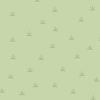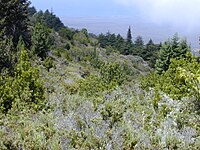Tag:natural=scrub
| Description |
|---|
| Uncultivated land covered with shrubs, bushes or stunted trees. |
| Rendering in OSM Carto |

|
| Group: natural |
| Used on these elements |
| Useful combination |
|
| See also |
| Status: de facto |
| Tools for this tag |
|
The tag natural=scrub is used to tag areas of uncultivated land covered with shrubs, bushes or stunted trees.
Scrub (shrubland, scrubland, brush) is a plant community characterized by vegetation dominated by shrubs (bushes and stunted trees), often also including grasses, herbs, and geophytes. It may be the mature vegetation type in a particular region and remain stable over time, or a transitional community that occurs temporarily as the result of a disturbance, such as fire.
In addition to use on natural habitats, natural=scrub is often used to tag semi-natural and semi-developed areas, such as areas of uncultivated shrubs along highways, and scrub in abandoned pasture which is transitioning back to forest.
natural=scrub is also used (or misused, depending on the point of view) for maintained, cultivated areas of landscaping or shrubbery[1], but this usage is considered controversial. An alternative is the newer natural=shrubbery which fills this niche, but which was rejected as a proposal in large part because, conversely, a significant number of mappers who voted against it felt that this natural=scrub should be used for this use case as well. Thus there are, broadly speaking, two conflicting standpoints for mapping cultivated shrubbery. For an in-depth explanation of this controversy, see the summary drafted in the aftermath of the two failed shrubbery proposals.
Tagging
natural=scrub applies to areas. Using a node instead is acceptable, but only as a temporary measure, since it does not reveal extent of the vegetation.
Additional tags
- name=* – name of the site, where available.
- leaf_type=broadleaved/needleleaved/mixed – describes the type of leaves.
- leaf_cycle=deciduous/evergreen/mixed – describes the phenology of leaves.
Mapping caveats
This tag should not be used for:
- Areas dominated by low-growing dwarf scrubs – use natural=heath instead.
- Open woodlands with full grown trees with significant gaps between them – depending on tree density use natural=wood or map what grows in between the trees.
- Cultivated scrub plantations – depending on the purpose these might qualify as landuse=orchard, landuse=farmland or leisure=garden.
- Hedges mapped as an area and beds of planted shrubs, that are manicured or otherwise actively maintained. There is work in progress to develop a fitting scheme for these, see natural=shrubbery.
Examples
Rendering
Notes
The widely-used Anderson (1976) classification system has detailed descriptions of scrub. Particular attention should be paid to these classifications:
- 3 Rangeland
- 31 Herbaceous Rangeland
- 32 Shrub and Brush Rangeland
- 33 Mixed Rangeland
Corresponding landcover types in National Landcover Database (NLCD2006) and National Landcover Database (NLCD2011) are modified from the Anderson system:
- 5 Shrubland
- 51 Dwarf Scrub - (Alaska only) areas dominated by shrubs less than 20 centimeters (0.66 feet) tall with shrub canopy typically greater than 20% of total vegetation. This type is often co-associated with grasses, sedges, herbs, and non-vascular vegetation. See natural=heath
- 52 Shrub/Scrub - areas dominated by shrubs; less than 5 meters (16.4 feet) tall with shrub canopy typically greater than 20% of total vegetation. This class includes true shrubs, young trees in an early successional stage or trees stunted from environmental conditions.
Herbaceous, sedge, lichen, moss and wetlands (woody or herbaceous) are better tagged as features other than 'scrub'.
See also
- leaf_type=* and leaf_cycle=*
- Vegetation
- natural=shrub for standalone plants
- natural=heath for dwarf scrub and healthland
- natural=shrubbery for an area of shrubbery that is actively maintained or pruned by humans. A slightly wilder look is also possible.
- landuse=shrubs for an area of cultivated shrubs
Common tagging mistakes
| ||||||||||||||||||||||||||||||||
- ↑
Examples of natural=scrub used in landscaped areas:
- https://osm.org/#map=18/51.97910/5.66844 - The Netherlands
- https://osm.org/#map=18/52.51886/13.42195 - Berlin, Germany
- https://osm.org/#map=19/39.10163/-94.58035 - Kansas City, USA
- https://osm.org/#map=18/-23.53937/-46.67479 - São Paulo, Brazil







